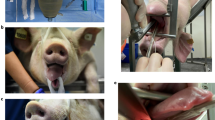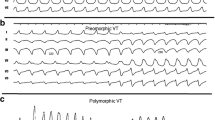Abstract
Purpose
Legislation and sentiment have pushed large-animal electrophysiological research from the canine to the swine model. Anecdotal experience suggests that the swine is particularly sensitive to ventricular fibrillation (VF) induction, and radiofrequency ablation studies are consistent with this. Currently, no data exist directly comparing the VF threshold (VFT) in humans to swine. Because of the perceived difference in vulnerability to VF induction, we hypothesized that the VFT would be lower in swine compared to humans.
Methods
Six anesthetized open-chested swine, 31 ± 2 kg, were studied that were part of an ongoing study with up to 6 h of previous closed-chest percutaneous pacing with repeated VF cycles. Similar to the human study of Horowitz et al., 24 pulses of 4 ms each were applied at a rate of 100 Hz during the ST segment to the epicardium via a pair of 7-mm diameter platinum electrodes whose centers were 15 mm apart. Current was increased until VF was induced.
Results
The swine right ventricle (RV) VFT was 9.7 ± 2.1 mA [median = 9.0, interquartile range (IQR) = 7.8–12.0], and the left ventricle (LV) VFT was 10.7 ± 2.2 mA [median = 10.5, IQR = 8.8–12.5] (p = NS). Horowitz reported the RV VFT in six patients as 24.3 ± 5.2 mA [median = 24.5, IQR = 19.0–29.3] and the LV VFT in ten patients as 33.6 ± 9.5 mA [median = 36.5, IQR = 27.3–42.3] (p = .11). Both the RV and LV VFTs were lower for swine (p < 0.003), and each of the mean and median VFTs for the ventricles together was one third that of the humans.
Conclusions
Swine are about three times as sensitive to the electrical induction of VF as are humans.


Similar content being viewed by others
Abbreviations
- DFT:
-
Defibrillation threshold
- ECG:
-
Electrocardiograph
- IQR:
-
Interquartile range
- LV:
-
Left ventricle
- RV:
-
Right ventricle
- UAB:
-
University of Alabama
- USDA:
-
US Department of Agriculture
- VF:
-
Ventricular fibrillation
- VFT:
-
Ventricular fibrillation threshold
References
(1991) Final rules: animal welfare; 9 CFR Part 3, USDA 0579-AA20.
European Commission (1986) Directive 86/609/EEC on the protection of animals used for experimental and other scientific purposes.
Pak, H. N., Kim, Y. H., Lim, H. E., Chou, C. C., Miyauchi, Y., Fang, Y. H., et al. (2006). Role of the posterior papillary muscle and Purkinje potentials in the mechanism of ventricular fibrillation in open chest dogs and Swine: effects of catheter ablation. Journal of Cardiovascular Electrophysiology, 17, 777–783.
Van Herendael, H., Zado, E. S., Haqqani, H., Tschabrunn, C. M., Callans, D. J., Frankel, D. S., et al. (2014). Catheter ablation of ventricular fibrillation: importance of left ventricular outflow tract and papillary muscle triggers. Heart Rhythm, 11, 566–573.
Nishida, K., Michael, G., Dobrev, D., & Nattel, S. (2010). Animal models for atrial fibrillation: clinical insights and scientific opportunities. Europace, 12, 160–172.
Holland, R. P., & Brooks, H. (1976). The QRS complex during myocardial ischemia. An experimental analysis in the porcine heart. Journal of Clinical Investigation, 57, 541–550.
Janse, M. J. (1998). Vulnerability to ventricular fibrillation. Chaos, 8, 149–156.
Gaum, W. E., Elharrar, V., Walker, P. D., & Zipes, D. P. (1977). Influence of excitability on the ventricular fibrillation threshold in dogs. American Journal of Cardiology, 40, 929–935.
Nimunkar, A. J., & Webster, J. G. (2009). Safety of pulsed electric devices. Physiological Measurement, 30, 101.
Cunningham, B. (2011). Draft guidance for industry and FDA staff: class II special controls guidance document: transcutaneous electrical nerve stimulator with limited output for pain relief. http://www.fda.gov/MedicalDevices/DeviceRegulationandGuidance/GuidanceDocuments/ucm198585.htm
(2006) Household and similar electrical appliances—safety—IEC 60335-2-76: particular requirements for electric fence energizers.
(2005) Effects of current on human beings and livestock, IEC/TS60479-1: effects of currents passing through the human body.
Walcott, G. P., Kroll, M. W., & Ideker, R. E. (2011). Ventricular fibrillation threshold of rapid short pulses. Conference of the IEEE Engineering in Medicine and Biology Society, 33, 255–258.
Ferris, L. P., King, B. G., Spence, P. W., & Williams, H. B. (1936). Effect of electric shock on the heart. Electrical Engineering, 55, 498–515.
Jacobsen, J., Buntenkotter, S., & Reinhard, H. J. (1975). Experimental studies in pigs on mortality due to sinusoidal and phase-controlled alternating and rectified currents (author’s transl). Biomedizinische Technik (Berl), 20, 99–107.
Chilbert, M. (1998). High-voltage and high current injuries. In J. Reilly (Ed.), Applied bioelectricity: from electrical stimulation to electrical pathology (pp. 412–453). New York: Springer.
Richardson, E. (2009) Intrapericardial delivery of anti-arrhythmic agents, PhD Thesis, University of Minnesota.
Stratbucker, R. A., Kroll, M. W., McDaniel, W., & Panescu, D. (2006). Cardiac current density distribution by electrical pulses from TASER devices. Conference of the IEEE Engineering in Medicine and Biology Society, 28, 6305–6307.
Wolf, P. D., Tang, A. S., Ideker, R. E., & Pilkington, T. C. (1992). Calculating endocardial potentials from epicardial potentials measured during external stimulation. IEEE Transactions on Biomedical Engineering, 39, 913–920.
Swerdlow, C. D., Olson, W. H., O’Connor, M. E., Gallik, D. M., Malkin, R. A., & Laks, M. (1999). Cardiovascular collapse caused by electrocardiographically silent 60-Hz intracardiac leakage current. Implications for electrical safety. Circulation, 99, 2559–2564.
Horowitz, L. N., Spear, J. F., Josephson, M. E., Kastor, J. A., & Moore, E. N. (1979). The effects of coronary artery disease on the ventricular fibrillation threshold in man. Circulation, 60, 792–797.
(1985) Position of the American Heart Association on research animal use, Circulation, 71(4), 849A–50A.
Darragh, K. M., Manoharan, G., Navarro, C., Walsh, S. J., Allen, J. D., Anderson, J. M., et al. (2012). Synchronized defibrillation for ventricular fibrillation. European Heart Journal Acute Cardiovascular Care, 1, 285–290.
Huang, J., Walcott, G. P., Ruse, R. B., Bohanan, S. J., Killingsworth, C. R., & Ideker, R. E. (2012). Ascending-ramp biphasic waveform has a lower defibrillation threshold and releases less troponin I than a truncated exponential biphasic waveform. Circulation, 126, 1328–1333.
Rollins, D. L., Wolf, P. D., Ideker, R. E., & Smith, W. M. (1990). A Macintosh based programmable cardiac stimulator. Journal of the American College of Cardiology, 15, A261.
Antoni, H. (1979). What is measured by the so-called threshold for fibrillation. Progress in Pharmacology, 2/4, 5–12.
Cha, Y.-M., Peters, B. B., Birgersdotter-Green, U., & Chen, P.-S. (1993). A reappraisal of ventricular fibrillation threshold testing. American Journal of Physiology, 264, H1005–H1010.
Dixon, M. E., Trank, J. W., & Dobell, R. C. (1964). Ventricular fibrillation threshold: variation with coronary flow and its value in assessing experimental myocardial revascularization. Journal of Thoracic and Cardiovascular Surgery, 47, 620–627.
Green, H. L., Raftery, E. B., & Gregory, I. C. (1972). Ventricular fibrillation threshold of healthy dogs to 50 Hz current in relation of earth leakage currents of electromedical equipment. Biomedical Engineering, 7, 408–414.
Swerdlow, C. D., Shehata, M., & Chen, P. S. (2007). Using the upper limit of vulnerability to assess defibrillation efficacy at implantation of ICDs. Pacing and Clinical Electrophysiology, 30, 258–270.
Dalziel, C. F., & Lee, W. R. (1968). Reevaluation of lethal electric currents. IEEE Transactions on Industry and General Applications, IGA-4, 467–476.
Geddes, L. A., Cabler, P., Moore, A. G., Rosborough, J., & Tacker, W. A. (1973). Threshold 60-Hz current required for ventricular fibrillation in subjects of various body weights. IEEE Transactions on Biomedical Engineering, 20, 465–468.
Cooper, D., Ye, Y, Rolf L Jr, & Zuhdi, N. (1991) The pig as potential organ donor for man, In: Xenotransplantation (pp. 481–500). Berlin Heidelberg: Springer.
Douglas, W. R. (1972). Of pigs and men and research. Space Life Sciences, 3, 226–234.
Hughes, H. (1986). Swine in cardiovascular research. Laboratory Animal Science, 36, 348.
Lumb, G. (1966). Experimentally induced cardiac failure in swine: pathological changes. In L. K. Bustad & R. O. McClellan (Eds.), Swine in biomedical research (pp. 389–403). Richland: Pacific Northwest Laboratory.
White, D., & Wallwork, J. (1993). Xenografting: probability, possibility, or pipe dream? Lancet, 342, 879–880.
Hamlin, R. L. (2007). Animal models of ventricular arrhythmias. Pharmacology and Therapeutics, 113, 276–295.
Crick, S. J., Sheppard, M. N., Ho, S. Y., Gebstein, L., & Anderson, R. H. (1998). Anatomy of the pig heart: comparisons with normal human cardiac structure. Journal of Anatomy, 193(Pt 1), 105–119.
Glomset, D. J., & Glomset, A. T. (1940). A morphologic study of the cardiac conduction system in ungulates, dog, and man: Part II: the purkinje system. American Heart Journal, 20, 677–701.
Sedmera, D., & Gourdie, R. G. (2014). Why do we have Purkinje fibers deep in our heart. Physiological Research, 63(Suppl 1), S9–S18.
Hamlin, R. L. (1960). The QRS electrocardiogram, epicardiogram, vectorcardiogram and ventricular excitation of swine. American Journal of Physiology, 198, 537–542.
Hamlin, R. L., Burton, R. R., Leverett, S. D., & Burns, J. W. (1975). Ventricular activation process in minipigs. Journal of Electrocardiology, 8, 113–116.
Huang, J., Dosdall, D. J., Cheng, K. A., Li, L., Rogers, J. M., & Ideker, R. E. (2014). The importance of Purkinje activation in long duration ventricular fibrillation. Journal of the American Heart Association, 3, e000495.
Cheng, K. A., Dosdall, D. J., Li, L., Rogers, J. M., Ideker, R. E., & Huang, J. (2012). Evolution of activation patterns during long-duration ventricular fibrillation in pigs. American Journal of Physiology—Heart and Circulatory Physiology, 302, H992–H1002.
Horowitz, L. N., Spear, J. F., & Moore, E. N. (1981). Relation of the endocardial and epicardial ventricular fibrillation thresholds of the right and left ventricles. American Journal of Cardiology, 48, 698–701.
Damiano, R., Smith, P. K., Tripp, H., Asano, T., Small, K., Lowe, J., et al. (1986). The effect of chemical ablation of the endocardium on ventricular fibrillation threshold. Circulation, 74, 645–652.
Spear, J., Horowitz, L., Moore, E. (1977) Relationship of endocardial and epicardial ventricular-fibrillation thresholds of right and left-ventricles. American Journal of Cardiology, 39, 274–274.
Wong, M. C., Edwards, G., Spence, S. J., Kalman, J. M., Kumar, S., Joseph, S. A., et al. (2013). Characterization of catheter–tissue contact force during epicardial radiofrequency ablation in an ovine model. Circulation. Arrhythmia and Electrophysiology, 6, 1222–1228.
Sacher, F., Wright, M., Derval, N., Denis, A., Ramoul, K., Roten, L., et al. (2013). Endocardial versus epicardial ventricular radiofrequency ablation: utility of in vivo contact force assessment. Circulation. Arrhythmia and Electrophysiology, 6, 144–150.
Li, G. R., Du, X. L., Siow, Y. L., Karmin, O., Tse, H. F., & Lau, C. P. (2003). Calcium-activated transient outward chloride current and phase 1 repolarization of swine ventricular action potential. Cardiovascular Research, 58, 89–98.
Li, G. R., Feng, J., Yue, L., & Carrier, M. (1998). Transmural heterogeneity of action potentials and Ito1 in myocytes isolated from the human right ventricle. American Journal of Physiology, 275, H369–H377.
Zygmunt, A. C. (1994). Intracellular calcium activates a chloride current in canine ventricular myocytes. American Journal of Physiology, 267, H1984–H1995.
Dudel, J., Peper, K., Rüdel, R., & Trautwein, W. (1967). The dynamic chloride component of membrane current in Purkinje fibers. Pflüger’s Archiv für die gesamte Physiologie des Menschen und der Tiere, 295, 197–212.
Conflict of interest
Authors have full control of all primary data and agree to allow the journal to review their data if requested. This work was funded by a grant from TASER International, Inc., and Dr. Kroll is a member of their corporate and scientific advisory board and holds their equity. Drs. Walcott and Ideker report no conflicts.
Author information
Authors and Affiliations
Corresponding author
Rights and permissions
About this article
Cite this article
Walcott, G.P., Kroll, M.W. & Ideker, R.E. Ventricular fibrillation: are swine a sensitive species?. J Interv Card Electrophysiol 42, 83–89 (2015). https://doi.org/10.1007/s10840-014-9964-1
Received:
Accepted:
Published:
Issue Date:
DOI: https://doi.org/10.1007/s10840-014-9964-1




